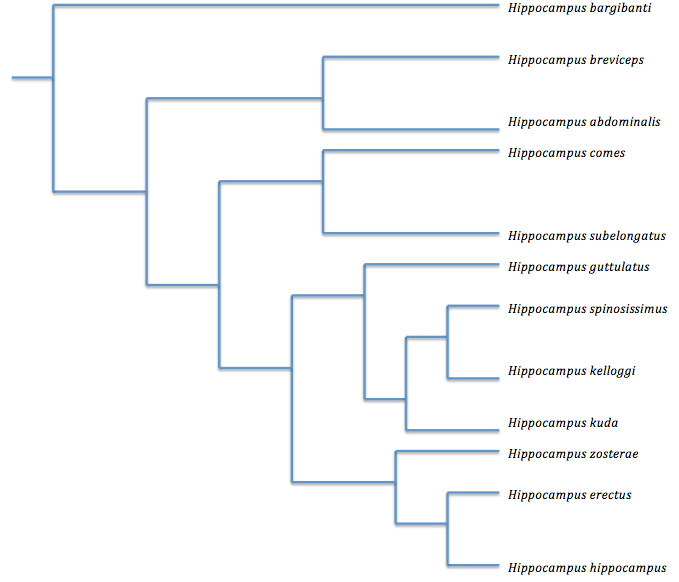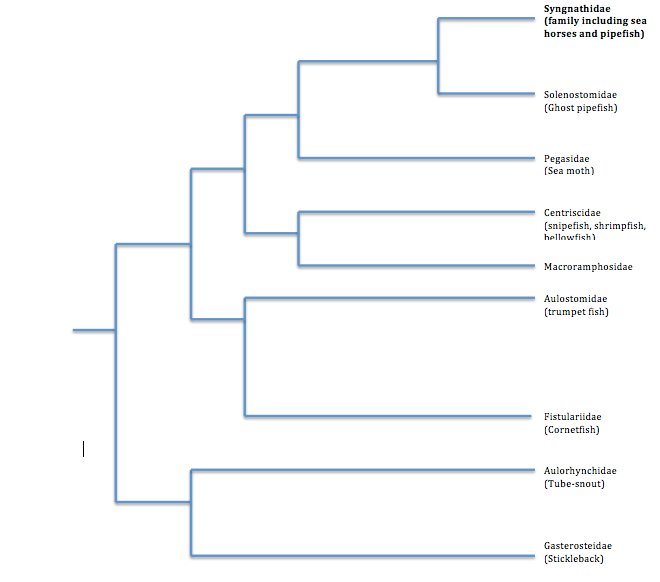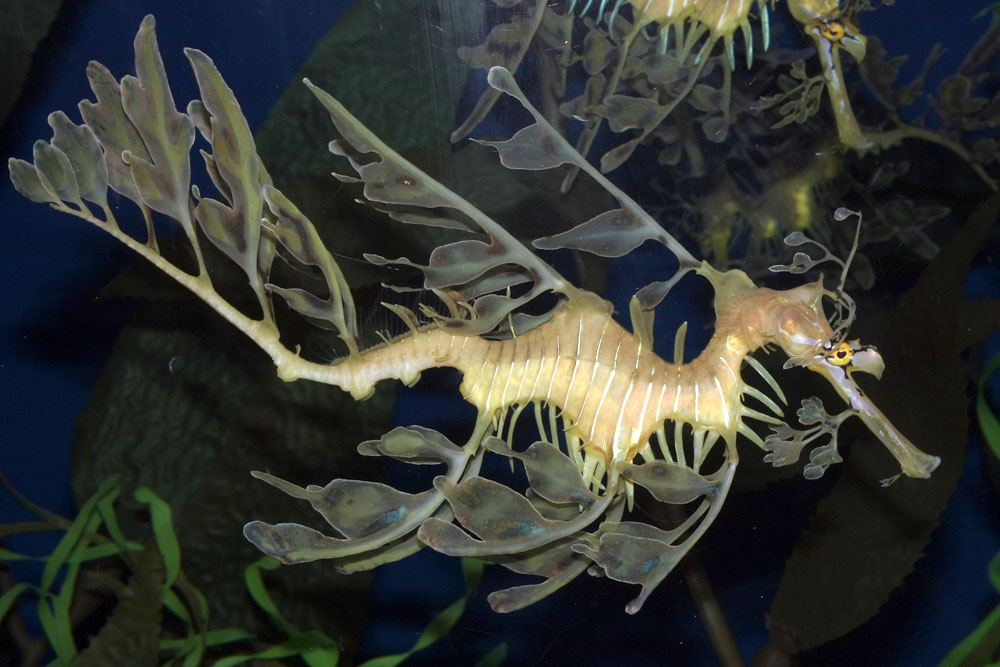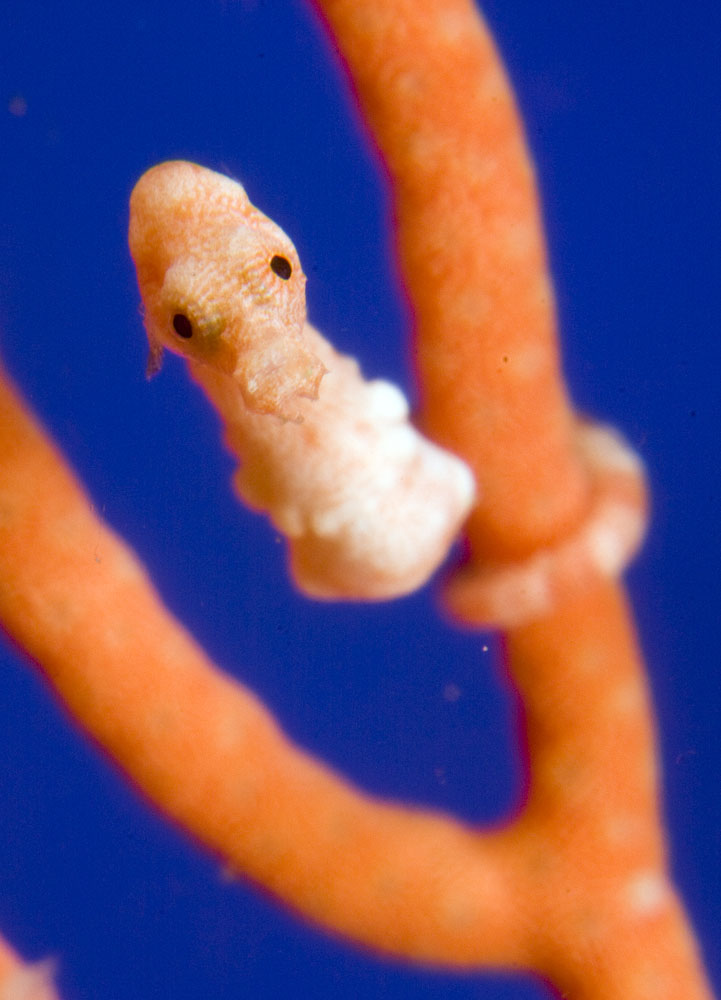Classification

Taxonomy (Encyclopedia of Life)
Domain: Eukarya
Kingdom: Animalia
Phylum: Chordata
Subphylum: Vertebrata
Class: Actinopterygii
Order: Gasterosteiformes
Family: Syngnathidae
Genus: Hippocampus
Species: Hippocampus bargibanti
Synapomorphies of these groups:
Eukarya: H. bargibanti is a member of the
domain Eukarya - “Eu” meaning “true” and “karya” meaning “nucleus.”
All Eukaryotes have cells containing a nucleus and membrane-bound
organelles.
Animalia: What makes an animal an animal? Members of the Animalia kingdom have the synapomorphy of
multicellularity and cells lacking a cell wall. They are
heterotrophic, meaning they rely on other organisms for food.
Chordata: H. bargibanti belongs in the phylum Chordata because it
has the synapomorphies of notochords and dorsal nerve cords. As it
is a member of the Chordata, it is a deuterostome - meaning that its
anus develops prior to its mouth - and a triploblast - meaning it
contains an endoderm, ectoderm, and mesoderm with bilateral
symmetry. It is also a member of the subphylum vertebrates because
it has vertebrate structures.
Actinopterygii: The class Actinopterygii includes all ray-finned
fishes (Encyclopedia of Life).
Gasterosteiformes: This order is not heavily researched, but
includes trumpet fishes, sticklebacks, snipefish, and sea moths
(Lourie and Foster 2004). A further breakdown and phylogenetic
analysis of this order that shows where the Syngnathidae family falls
in comparison to other members of the Gasterosteiformes is presented
in a phylogenetic tree below.
Syngnathidae: This family includes three major
groups: pipefishes (which have the
appearance of stretched-out/flat seahorses), seadragons (similar to
seahorses, but have appendages that camouflage them in seaweed), and
seahorses. All three groups have the synapomorphy of undergoing male
pregnancy (Lourie and Foster 2004). More information on this
incredible male pregnancy can be found
here.
These two images show the other two
major groups in the Syngnathidae family. The pipefish and seadragon
are the closest living relatives to the genus Hippocampus,
or seahorses.
Hippocampus: Pipefishes, seadragons, and seahorses then
differentiate at the genus level - H. bargibanti is in the genus
Hippocampus along with all other species of seahorses because of
their synapomorphies of having heads at right angles to trunks and
the presence of pre-hensile
tails. Seahorses also have a synapomorphy in the lack of a caudal
fin (Teske, Cherry, and Matthee 2004). This genus is said to have
existed for 20 million years. Currently, there are 32 different
identified species of seahorses, while some scientists estimate
there to be 50 in total (Lourie and Randall 2003).
Hippocampus bargibanti: Finally, at the last level of taxonomy, its
species name is H. bargibanti. There are a number of characteristics
that set this species of seahorse apart from the others. It has a
maximum height of only 2.4cm (most seahorses fall within the range
of 10cm to
30cm, so this species is tiny in comparison) and has three trunk
rings, along with an extremely short snout. It is very closely
related to two other species of seahorses: H. minotaur and
H. denise
(Lourie and Foster 2004). H. denise is shown below. Many
similarities can be seen, most notably in the small stature and
camouflage.
Meaning of name
So where did the name Hippocampus bargibanti come from? “Hippos” has the root meaning “horse,” while “kampos” means “sea monster.” This species was discovered in 1969 by scientist Georges Bargibant, from which the specific epithet of “bargibanti” came from (Lourie and Randall 2003).
Common names: H. bargbanti is also known by its common names, often times being most generally referred to as a pygmy seahorse. This is misleading, however, as there are other species of pygmy seahorses - seven in total (Lourie and Foster 2004). It is also commonly referred to as “Bargibant’s seahorse,” again after the scientist who discovered this species in 1969 (Lourie and Randall 2003).
Phylogenetic trees:

This phylogenetic tree shows where H. bargibanti falls in relation to other species of
seahorses. To learn more about another closely related Hippocampus
species, visit
Hippocampus kelloggi.
The tree was created by one of this website's authors, Kelly,
using information from:
Teske, P. R., M. I. Cherry, and C. A. Matthee. 2004. The
evolutionary history of seahorses (Syngnathidae: Hippocampus):
molecular data suggest a West Pacific origin and two invasions of
the Atlantic Ocean. Molecular Phylogenetics and Evolution
30(2):273-286.

This phylogenetic tree shows where the family
Syngnathidae falls (which includes all species of the genus
Hippocampus) within the order Gasterosteiformes.
This tree was created by one of this website's authors, Kelly, using
information obtained from:
Wilson, A. B., and J. W. Orr. 2011. The evolutionary origins of
Syngnathidae: pipefishes and seahorses. Journal of Fish Biology 78:
1603-1623.
Next, learn about this pygmy seahorse's habitat!
To go back to the home page, click here.


